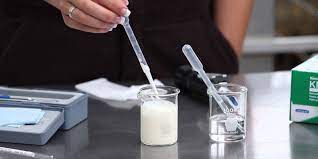IIT Madras researchers develop pocket-friendly device to detect adulteration in milk
Blog Credit: Trupti Thakur
Image Courtesy: Google
Due to the nutritive value of milk, its testing and quality control is an essential components of any milk processing industry whether small, medium or large scale. Milk is made up of 87% water hence making it prone to adulteration by unscrupulous middlemen and unfaithful farmworkers.
The most common tests used to determine milk quality are somatic cell count (SCC), standard plate counts (SPC), preliminary incubation counts (PIC), lab pasteurized counts (LPC), and coliform counts. The SCC is a measure of body cells and white blood cells present in milk.
In just 30 seconds, a cost-effective and portable 3D paper-based device developed by researchers at IIT Madras can detect milk adulteration.
In just 30 seconds, a cost-effective and portable 3D paper-based device developed by researchers at IIT Madras can detect milk adulteration. This device is unlike traditional laboratory-based methods and can be used at home with just one milliliter of the liquid sample needed for testing. The device is capable of identifying various commonly used adulterating agents, including but not limited to detergents, soap, hydrogen peroxide, urea, starch, salt, and sodium-hydrogen-carbonate.
IIT Madras: Pocket-friendly device to detect adulteration in milk:
Dr. Pallav Sinha Mahapatra, an Associate Professor in the Department of Mechanical Engineering at IIT Madras, along with Research Scholars Mr. Subhashis Patari and Dr. Priyanka Datta, led this research.
The 3D paper-based microfluidic device comprises a middle layer with a sandwich structure, a top cover, and a bottom cover.
This 3D design facilitates the consistent transportation of denser liquids at a steady pace.
To prepare the device, the paper is treated with reagents and allowed to dry.
Once dry, both paper layers are attached to both sides of the support, and the covers are then affixed using double-sided tape.
The design employs Whatman filter paper grade 4, which enables the flow of liquid and can store more reagents.
Issues of the Milk Adulteration
Although milk is a fundamental food item for maintaining a healthy lifestyle, it is one of the most commonly adulterated food items worldwide.
The adulteration of milk is particularly concerning in developing countries like India, Pakistan, China, and Brazil.
The consumption of adulterated milk can lead to various medical issues such as kidney problems, gastrointestinal complications, diarrhea, infant mortality, and even cancer.
This cost-effective and portable 3D paper-based device that can detect milk adulteration in just 30 seconds. Unlike conventional laboratory-based methods, this new technology can be used at home and requires only a millilitre of the liquid sample to test for adulterants.
The device can detect various commonly used adulterating agents such as detergents, soap, hydrogen peroxide, urea, starch, salt, and sodium-hydrogen-carbonate, among others.
The research was led by Dr. Pallab Sinha Mahapatra, Associate Professor in the Department of Mechanical Engineering at IIT Madras, along with research scholars Subhashis Patari and Driyankan Datta. They co-authored a research paper that has been published in the peer-reviewed journal Nature.
DEVICE DESCRIPTION
The 3D paper-based microfluidic device is composed of a top and bottom cover and a sandwich structure middle layer. This 3D design helps transport denser liquids at a consistent speed.
The paper is treated with reagents and left to dry. Both paper layers are then adhered to both sides of the support after drying, and the covers adhere with double-sided tape.
Whatman filter paper grade 4 is used in this design, which allows for liquid flow and storage of more reagents.
Blog By: Trupti Thakur

31
MarMilk Adulteration Detection Device – By IIT Kanpur
Mar 31, 2023Recent Blog
Vikram 3201 & Kalpana 3201Apr 04, 2025
The Open Weight Language ModelApr 03, 2025
Asia Cup 2025Apr 02, 2025
The CrocodilusApr 01, 2025
SARATHIMar 31, 2025




